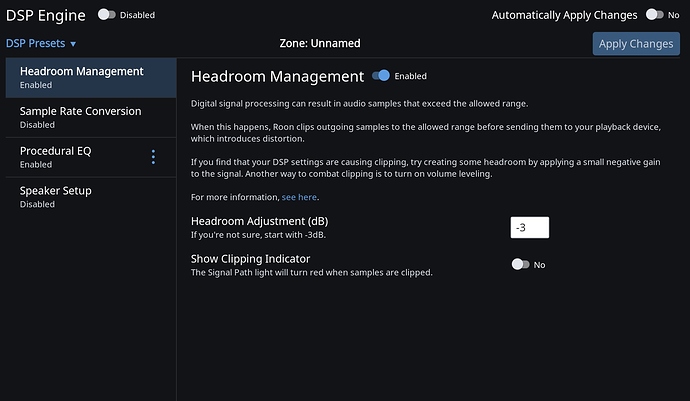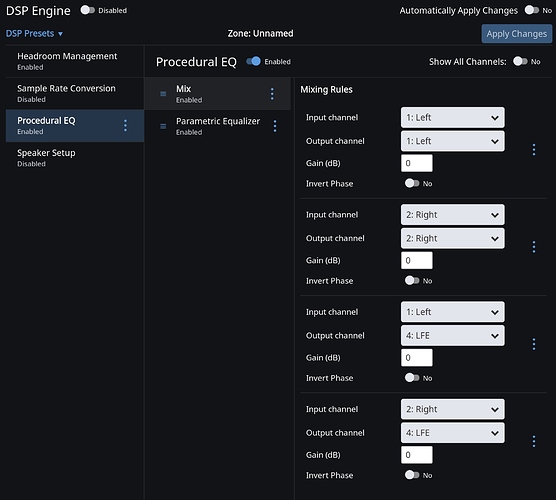I’m new to Roon. Is there any way to upmix 2.0 to 2.1 via Roon? My processor (Outlaw) does not offer it as an option. I’ve been using JRiver, and it does give one the option. I’m using Quad ESL 63’s as my fronts, and would like to be able to cross over at 80hz. Thanks in advance!
Gino
Yes, but you will need to create manually a bass management routine (channel summation, crossover frequencies, etc.) in the Roon DSP engine.
AJ
I’ve heard mention of using the Procedural EQ to create 2.1… I wasn’t able to make heads nor tails of what I was doing when I tried, however. Is there an Idiots Guide to Procedural EQ? Again, thanks in advance!
Gino
Rough guide, in order (which matters)
1 - Add some headroom (to avoid clipping), you may need to adjust amount as detailed in in the KB article.
1b - Add a procedural EQ to use for the next two steps.
2- Mix the channels to the LFE, making sure to keep the left & right intact
3- Use a parametric EQ as a crossover (this example just has a low-pass applied to LFE, you could also add another one for the opposite (high pass) to the left & right channels), play around and see what sounds best to you.
Here is the KB article for DSP
Hope this is helpful !
S
Wow. Thank you very much. Unfortunately, I’ve been called away for an emergency and won’t likely have a chance to give this a shot until tomorrow evening. I’ll report back once I have a chance to play.
Thanks again!
Gino
This is great information, thank you for sharing. I’m running a 2.2 stereo setup and just implemented this for bass management. LP filter for the LFE and a second HP filter for left and right.
Compared to the bass management in my amp (80hz LP and HP cutoffs for subs and mains), mid-bass seems a little too punchy.
The filters are pretty flexible, so keep tweaking until you get the sound you like. Things to try:
1/ Perhaps LFE bass is too loud (as it was summed from left & right), lower the overall level of the LFE, start with -3db which is about 0.5 the power. (slider on right hand side of procedural EQ)
2/ Changing the slope of filter (to make the roll-off more gradual (6dB Octave) or steeper (36dB Octave)), start with 24dB/Octave. If you like what your AVR did, check the manual to see what slope it used (it may even be different for the LFE low-pass and the main high-pass).
3/ Changing the crossover points based on your main speaker response specification rather than 80hz.
Thanks. Any idea which should come first in the processing chain, Procedural EQ or Convolution Filters?
Apologies, I am not super familiar with using convolution filters. However if room correcting, I would assume last step for the convolution filters and based on room measurements with procedural steps all enabled.
Thanks, that was my thought as well.
Well, I’ve played with this extensively and can’t get it to work properly.
My amp/streamer (Lyngdorf TDAI-1120) has built in speaker management.
For the L/R, I can select “full range” or “crossover”. If I select “crossover”, I can set a HP filter. The same settings apply for subwoofers, although it’s a LP filter. There’s also the ability (expectation) to enter speaker distances, both for L/R and both subwoofers.
Since I’m attempting to handle the speaker management in Roon, I’ve set L, R, and subwoofers to full range, and in Roon, I set up Procedural EQ, created a mix as shown above, and also created a HP for L/R. I matched the same slope (24db/octave) as I was using in the Lyngdorf. Speaker distances cannot be deleted, but since I’m not using that feature in Roon, it shouldn’t matter.
The sound is terrible, all mid range and upper bass, compressed, and muddy. No treble at all. I’m thinking there’s a conflict with how the Lyngdorf is handling things. My main interest in getting this to work was so that I can move to a separate DAC and amp and hand off all DSP to Roon. ![]()
You are barking up the wrong tree here. Using Roon Procedural EQ for bass management entails creating and outputting a multichannel signal. Thus, you need to have a true multichannel component to receive the signal. Lyngdorf is not that. It has only two channel inputs.
As above, unless the DAC is multichannel — and there are few of those — this will not work.
AJ
Thank you for clarifying.
Just to ensure I understand, if a DAC has a pair of balanced outputs and a pair of single ended outputs, would that work or does it have to have 4 independent outputs (channels)?
Yes, of course!
And for everyone following the above guide, when summing both channels into the LFE, enter -6.1dB (which is rounded up to one decimal point) for left and right to not cause clipping.
Thank you.
I’ll probably try this out with an inexpensive DAC first. Assuming the results are as expected, which manufacturers make “audiophile” 4 channel (or more) DACs?
Edit: I guess I could use 2 stereo DACs…
How? What interface are you going to use to receive multichannel audio from Roon and convert to two distinct USB or S/PDIF connections to two separate DACs? This does not work the way that you envision it.
Your Lyngdorf already has built in the requisite two channel input, four channel output hardware/software. Running with it is your best bet.
AJ
Thanks AJ…I realized after I posted that 2 separate DACs would be problematic.
While the Lyngdorf is good, I’d like the flexibility to do something different with DACs, amplification, etc. The Lyngdorf also resamples everything to 24/96, which I’d like to get away from if possible.
@stubaggs, since a multichannel DAC is required for this to work properly, would you mind sharing what DAC you’re using?
I was using an PC + old AVR (long story, but I wanted the rear speakers to act as the mains, so used a combo of the crossover approach described here and some channel mapping).
This method should work with any multichannel DAC.
I use the Okto dac8pro for 2.1, 5.1 and Dolby Atmos 5.1.2 formats, as Roon and the Okto max out at eight channels. As multichannel DACs go, the Okto is pretty reasonably priced and is a very fine component. JCR


